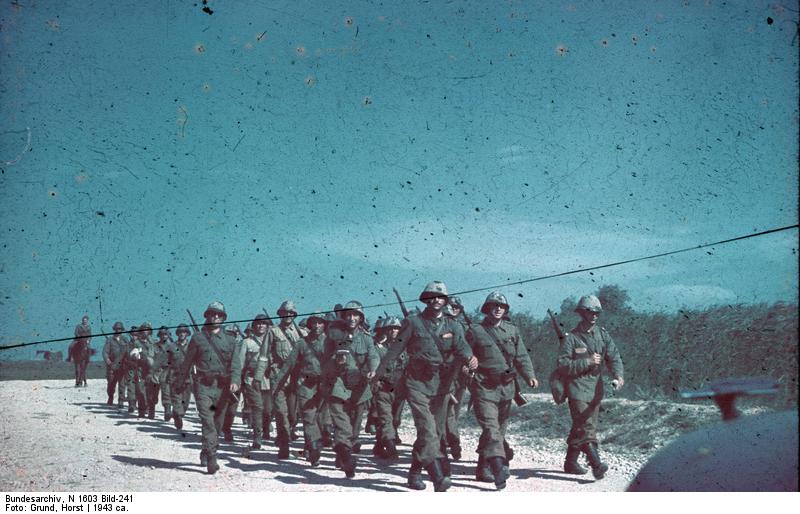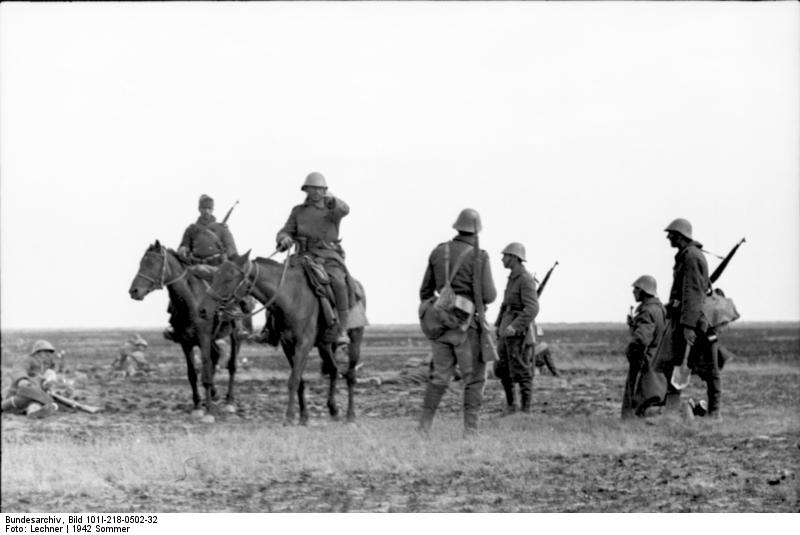Red Victory:
The Royal Romanian Army
by Mike Bennighof, Ph.D.
December 2022
 By the spring of 1944, the Royal Romanian Army had been at war for almost three years. During that stretch it had played the leading role in liberating the “lost province” of Bessarabia and capturing the fortress-cities of Odessa and Sevastopol. It had also suffered catastrophic losses at Odessa in 1941 and again at Stalingrad in 1942, so serious that much of the army had been withdrawn to the homeland during the course of 1943. By the spring of 1944, the Royal Romanian Army had been at war for almost three years. During that stretch it had played the leading role in liberating the “lost province” of Bessarabia and capturing the fortress-cities of Odessa and Sevastopol. It had also suffered catastrophic losses at Odessa in 1941 and again at Stalingrad in 1942, so serious that much of the army had been withdrawn to the homeland during the course of 1943.
That still left some of the best Romanian divisions at the front. The Cavalry Corps and Mountain Corps remained in the Crimean Peninsula, which had been isolated by the Soviets in November 1943. In all three mountain and two cavalry divisions remained in the Crimea, along with two infantry divisions. All were understrength and Romania’s Conducator, the military dictator Ion Antonescu, wished them returned home. German leader Adolf Hitler, the greatest command of all times, insisted that Crimea must be held or Soviet planes based there could attack the Romanian oil fields at Ploesti.
In early April 1944, the Soviets broke through the Perekop Isthmus leading from the Ukrainian mainland into Crimea, and a month later they had taken the last Axis foothold at the former Soviet naval base of Sevastopol. Slightly more than half of the Romanian troops in Crimea were evacuated (34,000 of 65,000). Meanwhile, the Soviets had opened a major offensive against Romania herself.

Some well-fed Romanians on the march.
The Crimean disaster meant that at some point in the war, every Romanian division had suffered enough losses to be rendered combat-ineffective. Since the destruction of the Third and Fourth Romanian Armies at Stalingrad, the War Ministry had been working to rebuild the army’s combat capabilities. New recruits filled out the ranks of the depleted divisions, but arming them and leading them presented severe difficulties. Romania had lost 40 percent of the small arms sent into Russia and 80 percent of the junior and field grade officers and NCO’s.
Throughout 1943, the Romanians pressed the Germans to deliver promised arms shipments, purchases paid for with hard currency. The Germans continually slow-walked the orders, or insisted on delivering them to the front where German units often pilfered them before they arrived at Romanian divisions. The Germans also substituted inferior weapons for those purchased by their allies; Romanian orders for the very effective PAK43 75mm gun, for example, were often filled with the PAK97 75mm weapon, a refurbished French light artillery piece originally issued during the previous century.
With little help coming from their allies, the Romanians repaired and refurbished the mountains of Soviet artillery and small arms they had captured in the 1941 and 1942 campaigns and put them to use, and began to manufacture ammunition for them. They also produced their own mortars and anti-tank guns. But they could not make up the losses of motor vehicles and tanks, nor could they replace the hundreds of thousands of horses killed over the previous campaigns.
Things began to change in March 1944, following a meeting between Hitler and Antonescu during which the German leader pledged to maintain a set number of panzer divisions in Romania. And during that month, the German occupied Romania’s rival Hungary and imprisoned its military dictator, Admiral Miklos Horthy. The Germans had kept a balance of power between their rival allies by favoring Hungary for arms deals to offset Romania’s greater resources. Now weapons formerly reserved for the Hungarians (and often produced in Hungarian factories for German use) now flowed into Romanian depots: rifles, machine guns, artillery pieces and most importantly heavy anti-tank guns.

Romanian troops in the Soviet Union.
Now flush with arms, the Romanians bulked up their infantry divisions from the previous establishment of six infantry battalions to the nine they had had before the Odessa campaign. The officer shortage could be eased somewhat thanks to Antonescu’s hoarding of young officers; while declaring his eternal allegiance to the Axis alliance, the Conducator had held back the 1941, 1942 and 1943 graduating classes from Romania’s military academy from combat assignments, preferring to send desk-bound deadwood to the front in their place. Romanian divisions still only had 75 percent of their officer establishment, though Romanian platoons called for more leaders than those of most other armies.
On paper, Romanian divisions were well-organized for defense. Each division had three infantry battalions plus engineer, anti-tank and heavy mortar (120mm) companies plus a cavalry squadron. Each battalion had three rifle companies and a weapons company with sixteen heavy machine guns and four medium mortars (81mm). Since Romania produced a surplus of mortars, the troops went to war with plenty of tube jockeys – some divisions had additional 120mm companies. The 47mm anti-tank guns, no longer effective against the newest Soviet tanks, had a very good high-explosive round and reverted to their original role as infantry guns.
The infantry division had four artillery battalions (one 150mm, one 100mm or105mm, one 75mm), recon and engineer battalions, an anti-aircraft company and two additional anti-tank companies. It lacked heavy flak, and had few motor vehicles, relying on horses to move its heavy weapons and its supplies. The Romanian infantry had the firepower to hold their fortified lines. If they were forced to engage in mobile warfare, their lack of vehicles to move all of those weapons would lead to their rapid destruction. That made the presence of German armored reserves crucial to Romania’s defense, and in July those reserves left to help stem the panicked retreat of the German Army Group Center.
 Antonescu had never fully believed in an Axis victory, as even before the Stalingrad disaster he had ordered new defensive works built along Romania’s frontiers with additional concrete emplacements, pillboxes and artillery positions. Both the Third and Fourth Armies returned to the front in April with 17 infantry divisions, two mountain divisions and three cavalry divisions; another four infantry and two mountain brigade-sized commands were formed from the training establishments of incomplete divisions. A handful more units would join them by August, including Romania’s lone armored division. Antonescu had never fully believed in an Axis victory, as even before the Stalingrad disaster he had ordered new defensive works built along Romania’s frontiers with additional concrete emplacements, pillboxes and artillery positions. Both the Third and Fourth Armies returned to the front in April with 17 infantry divisions, two mountain divisions and three cavalry divisions; another four infantry and two mountain brigade-sized commands were formed from the training establishments of incomplete divisions. A handful more units would join them by August, including Romania’s lone armored division.
Neither of the Romanian army staffs had full control of their own troops. Romanian divisions were intermingled with German formations, and German commanders called the shots even at nominally Romanian corps headquarters. Each Romanian army was paired with a German army, whose commander and staff likewise made the important decisions.
After fending off the April and May Soviet offensives, the front briefly became quiet while the Red Army brought up reinforcements and supplies for another round. Meanwhile, the Germans withdrew their panzer divisions and Adolf Hitler changed his focus from maintaining the alliance to berating Romania for what he termed unfair trade practices. The threat of a trade war in the midst of an existential military crisis enraged Antonescu, who now saw a separate peace as Romania’s only path forward.
Click here to order Defiant Russia: Red Victory right now.
You can order Defiant Russia (Playbook Edition) right here.
Defiant Package
Defiant Russia (Playbook)
Red Victory
Retail Price: $74.98
Package Price: $60
Gold Club Price: $48
You can experience the Defiant Package right here.
Sign up for our newsletter right here. Your info will never be sold or transferred; we'll just use it to update you on new games and new offers.
Mike Bennighof is president of Avalanche Press and holds a doctorate in history from Emory University. A Fulbright Scholar and NASA Journalist in Space finalist, he has published countless books, games and articles on historical subjects.
He lives in Birmingham, Alabama with his wife and three children. He misses his dog, Leopold.
Want to keep Daily Content free of third-party ads? You can send us some love (and cash) through this link right here. You don’t have to, but Leopold would like it if you did.
|
